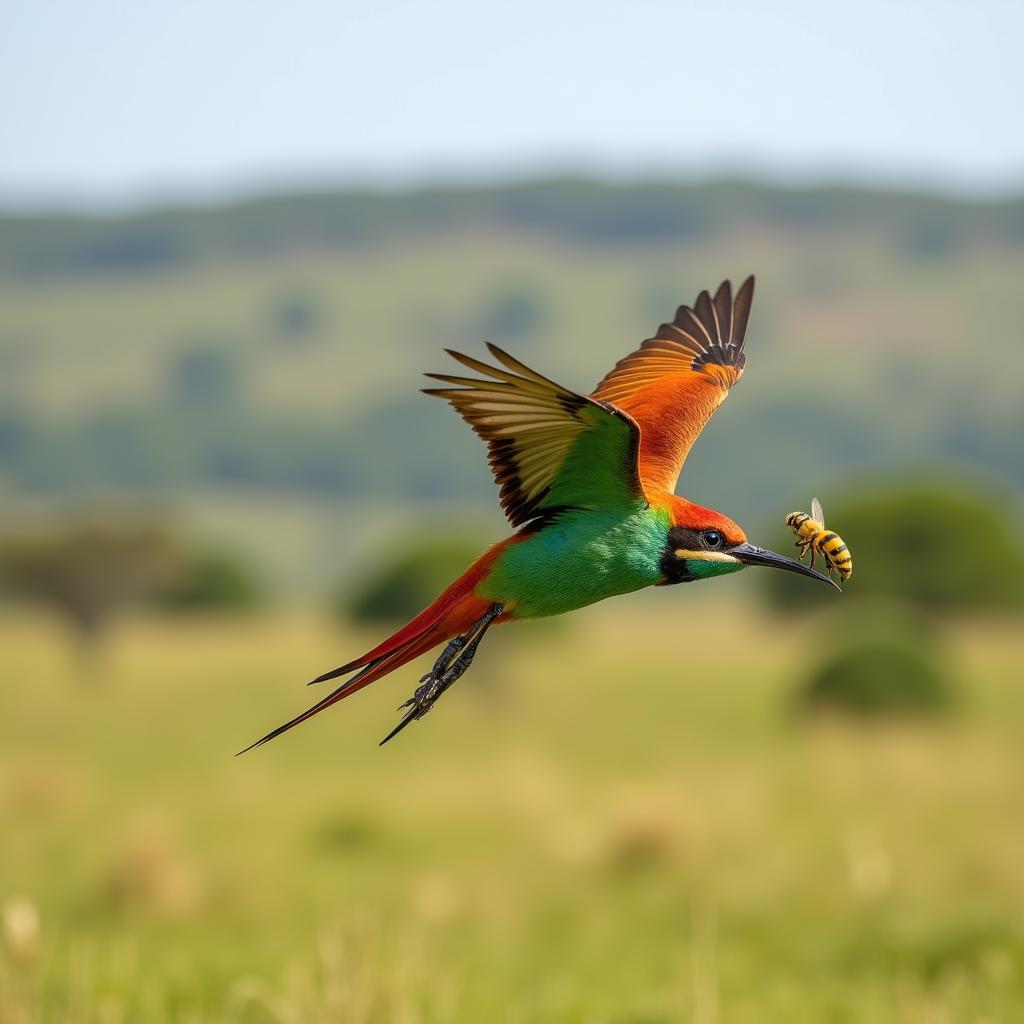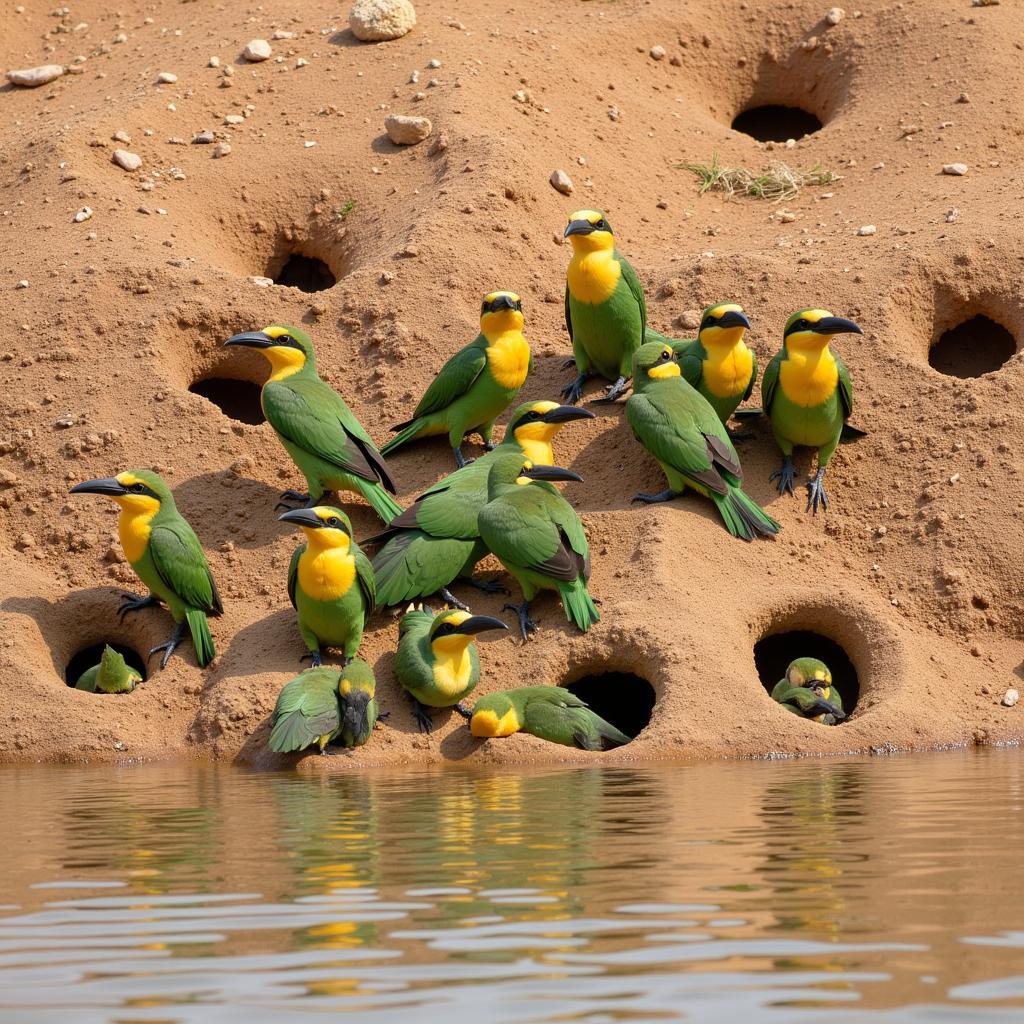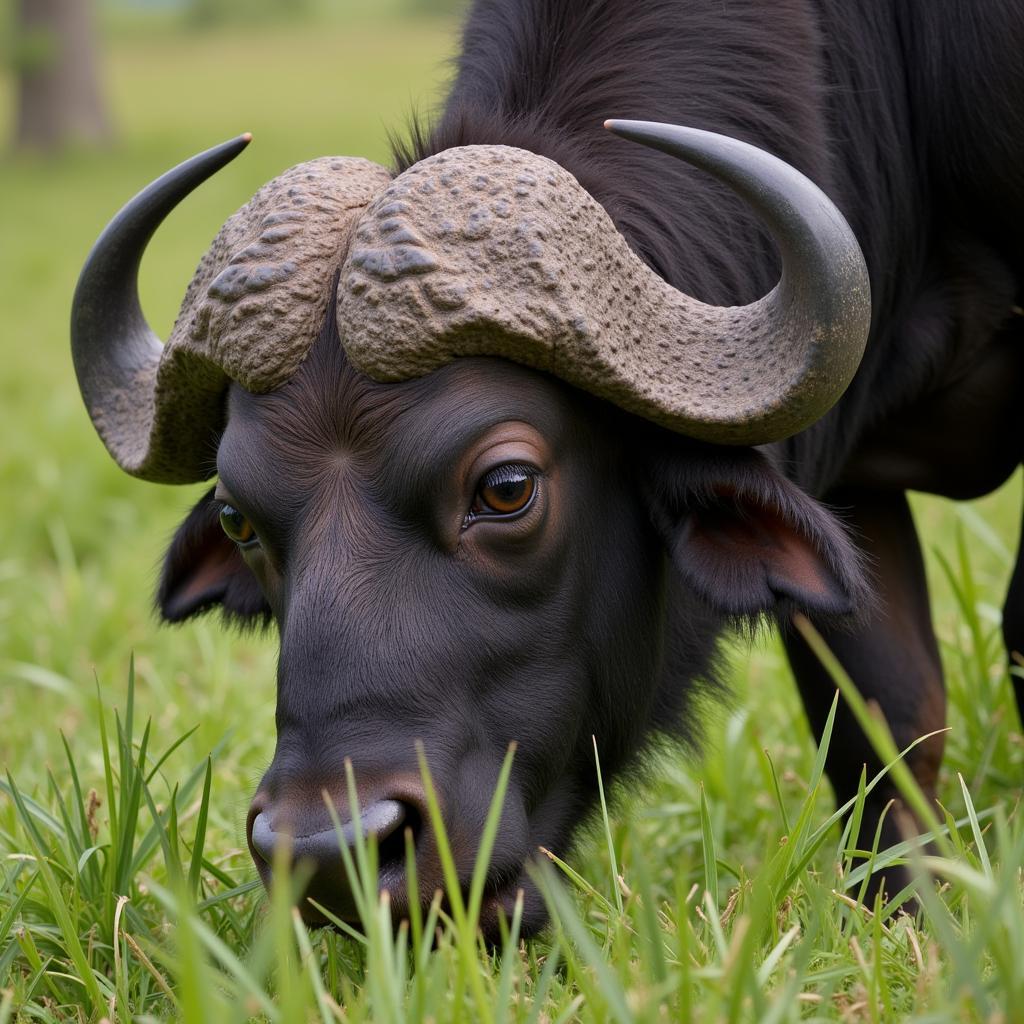The Vibrant World of the African Bee Eater
The African Bee Eater, a jewel of the avian world, graces the skies of Africa with its vibrant plumage and acrobatic flight. These birds, known for their specialized diet of insects, particularly bees, are a fascinating subject for bird enthusiasts and nature lovers alike. They represent a captivating blend of beauty, ecological significance, and unique behavioral traits that make them stand out in the diverse fauna of the African continent.
Unveiling the Secrets of the African Bee Eater
African bee eaters belong to the family Meropidae, a group of near passerine birds characterized by their richly colored feathers, slender bodies, and elongated central tail feathers. Within this family, several species are referred to as “African bee eaters,” adding to the richness and diversity of the continent’s birdlife. Their presence adds a splash of color to various habitats, from savannas and woodlands to riverbanks and coastal areas. One captivating aspect of these birds is their aerial prowess. They are adept hunters, catching insects mid-flight with remarkable precision. This ability not only showcases their agility but also highlights their important role in controlling insect populations. Shortly after catching their prey, these birds will often return to a preferred perch to remove the stinger before consuming the insect.
After this introductory overview of African bee-eaters, let’s explore their different species. African green bee eater offers a starting point to explore this fascinating bird further.
A Rainbow of Bee-Eater Species
Several species fall under the umbrella term “African bee eater,” each possessing unique characteristics that add to the tapestry of African biodiversity. The Carmine Bee-eater, with its vibrant crimson plumage, is perhaps one of the most recognizable. Their large colonies, often found nesting in riverbanks, create a spectacle of color and activity. The White-fronted Bee-eater, as its name suggests, has a distinctive white patch on its forehead, contrasting beautifully with its green back and chestnut underparts. The Little Bee-eater, true to its name, is the smallest of the group, known for its bright green upperparts and yellow throat. These are just a few examples of the diverse array of bee-eater species found across Africa. Each species plays a distinct role in their respective ecosystems, showcasing the interconnectedness of life on the continent.
 African Bee-eater catching a bee mid-air
African Bee-eater catching a bee mid-air
Habitat and Distribution: A Pan-African Presence
African bee eaters are found across sub-Saharan Africa, inhabiting a wide range of environments. From the open savannas of East Africa to the woodlands of West Africa, these birds have adapted to diverse habitats. Their presence adds a vibrant touch to the landscapes they call home. They can be found near water sources, along forest edges, and even in urban areas, demonstrating their adaptability and resilience. Their distribution is influenced by factors such as food availability, nesting sites, and climatic conditions. Understanding these factors provides insights into the ecological dynamics of these fascinating birds.
Social Behavior and Nesting Habits
African bee eaters are highly social birds, often forming large colonies. These colonies provide a sense of community and protection, particularly during the breeding season. Their nesting habits are equally fascinating. They typically excavate burrows in riverbanks or sandy cliffs, creating safe havens for their young. The cooperative breeding behavior exhibited by some species, where helpers assist in raising the young, is a testament to their social complexity.
 African Bee-eaters nesting in a colony
African Bee-eaters nesting in a colony
Consider the words of Dr. Anika Moosa, an ornithologist specializing in African birdlife: “The social dynamics of African bee eaters are truly captivating. Their cooperative breeding behavior and intricate communication within the colony highlight their intelligence and adaptability.”
The African Bee Eater’s Role in the Ecosystem
African bee eaters play a crucial role in maintaining the ecological balance of their habitats. As insectivores, they contribute to regulating insect populations, preventing outbreaks that could harm crops or disrupt natural ecosystems. Their presence also serves as an indicator of environmental health. Changes in bee-eater populations can signal environmental degradation or shifts in insect populations, providing valuable insights for conservation efforts.
aaa africanized bee removal discusses another aspect of bee management which can provide valuable insights when looking at the role of the bee-eater in the ecosystem.
Conservation Status and Threats
While many African bee eater species are not currently considered endangered, some face localized threats. Habitat loss due to deforestation and urbanization is a growing concern. Pesticide use can also negatively impact their populations by reducing insect prey and posing direct risks to the birds themselves. Conservation efforts are essential to ensure the continued survival and prosperity of these vibrant birds.
Conclusion: Appreciating the African Bee Eater
The African bee eater, with its vibrant colors, aerial acrobatics, and fascinating social behaviors, is a testament to the richness of African biodiversity. Understanding their ecological role, conservation status, and unique characteristics allows us to appreciate these birds not just for their beauty but also for their contribution to the natural world. Let’s continue to explore and protect these avian jewels, ensuring that they continue to grace the African skies for generations to come.
FAQ
- What do African bee eaters eat? Primarily insects, especially bees, wasps, and hornets.
- Where do African bee eaters live? Across sub-Saharan Africa in diverse habitats.
- How do African bee eaters nest? They excavate burrows in riverbanks or cliffs.
- Are African bee eaters endangered? While many are not, some face localized threats.
- What is the significance of African bee eaters in the ecosystem? They help regulate insect populations and serve as indicators of environmental health.
- How many species of African bee-eaters are there? There are numerous species, each with unique characteristics.
- What are the main threats to African bee-eaters? Habitat loss and pesticide use are significant threats.
Common Scenarios and Questions
- Scenario: You see a group of brightly colored birds near a riverbank in Africa. Question: How can I identify if they are bee eaters?
- Scenario: You are concerned about declining bee-eater populations in your area. Question: What can I do to help conserve these birds?
- Scenario: You are interested in learning more about the different species of African bee eaters. Question: Where can I find reliable resources and information?
Further Exploration
For further information on related topics, you might be interested in learning more about the African embassy in india or exploring the cultural significance of African American My Life Dolls.
Contact Us
For further assistance or information, please contact us: Phone: +255768904061, Email: kaka.mag@gmail.com, or visit our office at Mbarali DC Mawindi, Kangaga, Tanzania. We have a 24/7 customer service team available to assist you.
